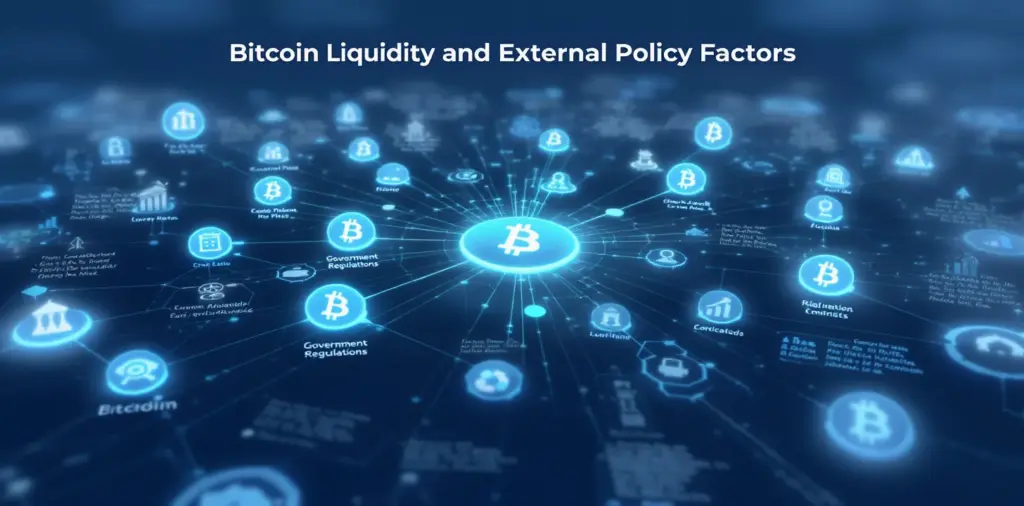Stress Test: Can Bitcoin’s New Liquidity Withstand Policy Shocks?

Lead
New highs are exhilarating; what matters is staying power. With bitcoin flirting around its Oct 5–7 record and ETF inflows still roaring, the right question isn’t “how high?” but “how durable?” To answer that, treat the market like an engineer: model stress on the ETF plumbing, the derivatives hedges, and the macro scaffolding surrounding them—starting with a Washington shutdown that’s depriving traders of oxygen (data) even as it supplies a narrative (diversification).
1) What if ETFs become net sellers?
In 2024, the SEC forced cash creations/redemptions. In 2025, it blessed in-kind for crypto ETPs. Under stress—say, a sharp drawdown—in-kind redemptions matter: APs can pull out coins instead of forcing issuers to sell spot for cash, reducing forced selling into thin air-pockets. That’s stabilizing compared with the old regime. It doesn’t eliminate volatility, but it smooths the mechanism that often turns outflows into price air-pockets. Think of it as a shock absorber installed between the ETF shares and the coin.
This is where AP count and caliber matter. More APs with crypto-native execution reduce single-point stress. As filings expanded the bench (Jane Street, Virtu, bulge-bracket primes), arbitrage resiliency improved. On days with $1B+ inflows—or mirror-image outflows—the presence of multiple APs is the difference between a market that wobbles and one that buckles.
2) The shutdown stressor: a data vacuum that tilts flows
Shutdowns scramble the calendar: agencies furlough staff, some releases are delayed, travel/logistics fray, and risk models that rely on timely macro signals get noisier. In that fog, allocators gravitate to assets with always-open liquidity and tidy access—enter the ETFs. The result this month: record weekly inflows into crypto ETPs and a new BTC high while the political noise rose. The market is effectively saying, “When in doubt, buy the thing with pipes that work.”
Yet the same uncertainty can reverse flows if the shutdown metastasizes into a broader risk-off. The stress test metric here: ETF discounts/premiums. Watch for persistent discounts at the U.S. close; that’s a sign the pipes are congested (redemptions outpacing AP capacity) and hedges are getting expensive.
3) Derivatives ballast: CME is the keel, not the sail
A sturdier market has ballast. Through mid-2025, CME open interest and volumes climbed as institutions hedged ETF flows and macro bets in listed futures. Hedging capacity means APs don’t need to spray the spot market to stay flat; they can synthesize exposure and unwind more gracefully. If BTC pulls back sharply, watch whether CME OI holds steady (good—hedges doing their job) or evaporates (bad—liquidity retreat).
And yes, options matter too: deeper listed options on ETF shares and futures can dampen realized volatility by spreading hedging flows across instruments. The practical test is intraday: do drawdowns accelerate into the U.S. close, or does dealer hedging flatten them? The former says “pipes are narrowing,” the latter says “pipes absorbed it.”
4) Supply discipline vs. miner stress
On the supply side, the April 2024 halving cut new issuance in half. Miners’ economics tightened, but the feared forced-selling wave never became systemic; data into mid-year showed miner revenues dipping without capitulation spikes. In a risk-off, miners can become marginal sellers—yet with ETF demand now the dominant flow, miner supply feels like weather, not climate. The structural lever is still the ETF hose width, not the daily block subsidy.
5) Liquidity’s new geography reduces—but doesn’t erase—gap risk
The migration of price discovery onto U.S. hours and into ETF benchmarks lowers the odds of off-hours air-pockets and improves gap-fill behavior. Kaiko and others documented the U.S. share of BTC-USD trading rising materially since 2021, with ETF volumes and benchmark windows acting as anchors. Still, concentration cuts both ways: if a shock hits just before the NAV window, the same gravity that usually stabilizes can amplify a move as everyone hedges at once.
6) The “store-of-value substitution” story—and its limits
This month’s all-time highs arrived alongside record crypto ETF inflows and narratives of bitcoin tracking gold as a “store-of-value” amid U.S. political noise. Correlations are mercurial, but the flows confirm the substitution effect: some investors swapped duration-heavy assets and stale cash for a 24/7 bearer asset with institutional wrappers. The limit case is obvious: if policy stress morphs into a growth shock, bitcoin trades like a high-beta macro asset again. Your stress test, therefore, is to assume both regimes can show up in the same month—and size accordingly.
7) Scenario map: how the next 30–60 days could play
Base case (stickiness): ETF inflows slow from torrid to steady; in-kind keeps discounts/premiums tight; dips are shallow and concentrated around the U.S. close. Highs consolidate rather than exhaust. Confirmation: deep order books near NAV hour, small ETF tracking error.
Chop case (flow whiplash): Another $1B+ single-day burst precedes a sharp 7–10% shakeout as dealers rebalance and retail chases late. Confirmation: funding spikes, CME basis wobbles, ETF prints small discounts into the close before normalizing.
Stress case (policy overhang): Shutdown drags, key data go dark, rates volatility pops, and bitcoin trades like equity beta. Here, resiliency lives in the pipes: if redemptions stay mostly in-kind and APs keep step, the drawdown is faster but cleaner; if discounts widen and CME OI shrinks, expect longer digestion.
8) The checklist that actually matters
- AP breadth: More names, more buffers.
- Discount/premium at the close: The ETF truth serum.
- CME OI and options depth: Are hedges absorbing or amplifying?
- Benchmark-window depth: Does liquidity arrive when it’s most needed?
- Global pipes: Non-U.S. ETF inflows (Switzerland, Germany) are now sizable enough to matter on rebalance days.
Bottom line: Bitcoin’s stress test is no longer a referendum on “crypto vs. the world.” It’s a question of market plumbing under duress. Right now, the pipes look ready. They won’t cancel volatility—they’ll structure it. That alone is a regime change worth paying for.
